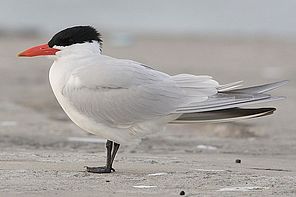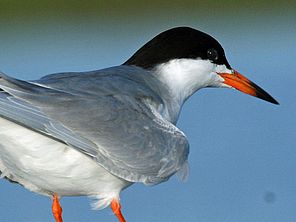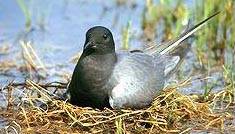Tern, Tern, Tern
September 2011
The sandbar at the mouth of Mill Creek in Port Henry is covered with loafing birds, white balls of feathers in various states of repose. Most are ring-billed gulls with a few other gulls mixed in, but two birds in particular stand out. They are the same size as the gulls with similar white plumage, but they have bright orange bills and a swept-back black crest like they just came from the salon. These are Caspian terns, one of three species of terns that can be found on Lake Champlain.
Caspian terns are relatively new arrivals on the lake. In 2001 the first confirmed nesting of a Caspian tern on Lake Champlain was recorded. A pair was found on Young Island, off of North Hero and on Popasquash Island off shore between St. Albans and Swanton, though it’s thought the nests were from the same pair of birds. In 2004 Caspian terns began nesting on Four Brothers Island and as of 2007 that colony had 50 pairs of birds. Lake Champlain hosts the only Caspian tern colonies in Vermont and the only other New York colony is on Little Galoo Island in Lake Ontario. The Lake Champlain population is consistent with a general North American expansion of the population, though European populations seem to be declining.
Caspian terns, the largest of the tern species, can be found throughout much of the world, but rarely in large numbers. In flight they are easily mistaken for more common gulls, but their behaviors and bright orange beak help distinguish them. While hunting, terns dive down on prey, un-like most gulls. They also hunt with their heads lowered to the water, a posture quite different from soaring gulls. Their voice, a raspy ‘kowk’ also differs from that of gulls.
Caspian terns mature slowly. Parents need to provide the young with food throughout the breeding season and even on the wintering grounds. Many young will remain on the wintering grounds for a few years before returning to breed.
While Caspian terns have increased in number, common terns have faced troubles. In the late 1960s, between 300 and 400 pairs of common terns nested on Lake Champlain, but by 1988 the population had fallen to just 50 pairs. The species is currently listed as ‘Endangered’ in Vermont and ‘Threatened’ in New York. The birds nest on small rocky islands in the lake. Work by Audubon Vermont, the Vermont Non-game and Natural Heritage Program, and the Lake Champlain Land Trust has increased the number of nesting terns since the late 1980s and now between 160 and 200 pairs nest on the lake.
Common terns are much smaller and more delicate than gulls or Caspian terns. Like Caspian terns they dive for their food, targeting small fish, up to three or four inches in length. Returns of banded birds indicate they can live at least a quarter century. Their vocalizations are also distinctive, described as a harsh, rolling ‘kee-urr’ with a downward inflection.
Common terns live in North and South America, Eurasia, and northern Africa. The birds winter from their southern most breeding grounds in South Carolina to northern Ecuador and Brazil. Other freshwater lakes in New York where common terns breed include Lake Erie, Lake Ontario, the St. Lawrence and Niagara Rivers, and Oneida Lake.
The third Lake Champlain tern species is the black tern. As their name suggests, these birds’ plumage is dark black and gray. In winter, the birds become more gray on the back and white on the underparts. Their voice is a sharp metallic ‘krik’.
Rather than nesting on islands, black terns prefer marshes with an even mix of open water and emergent vegetation. They build shallow, cup-like nests on floating vegetation, muskrat houses, fallen logs, or whatever else sits just above the water surface. Black terns tend to eat more insects (dragonflies and mayflies) and fewer fish than other tern species. As a result, black terns are more of an inland species compared to other terns. In North America the breeding range extends from central British Columbia east across the prairie provinces, south through the Great Plains and east into New England. By mid-August they have often left our region heading for wintering grounds in South America.
Local populations have been declining since the 1960s. At that time, there were 56 known breeding locations in New York along the southern and eastern shores of Lake Ontario, in marshes along the St. Lawrence River and inland marshes of western, central, and northwestern New York, but today fewer than 20 of the historic breeding sites are still active. In Vermont the birds had used up to eight different nesting locations but now can only be found nesting in the Missisquoi National Wildlife Refuge. While the causes of the species decline are not entirely evident, regulation of water levels in some locations have limited the natural fluctuations that promote the half open marshes preferred by the species. Black terns are ‘Endangered’ in both Vermont and New York.
The arrival of the Caspian tern and on-going recovery of common terns have been a boon for Lake Champlain bird-watchers. The aerial acrobatics and stunning dives of terns can bring gasps of wonder. Keep a close eye on those white birds over the lake, they may be more than just gulls.
Lake Look is a monthly natural history column produced by the Lake Champlain Committee (LCC). Formed in 1963, LCC is the only bi-state organization solely dedicated to protecting Lake Champlain’s health and accessibility. LCC uses science-based advocacy, education, and collaborative action to protect and restore water quality, safeguard natural habitats, foster stewardship, and ensure recreational access.
Get involved by joining LCC using our website secure form (at www.lakechamplaincommittee.org), or mail your contribution (Lake Champlain Committee, 208 Flynn Avenue - BLDG 3 - STUDIO 3-F, Burlington, VT 05401), or contact us at (802) 658-1414, or lcc@lakechamplaincommittee.org for more information.



